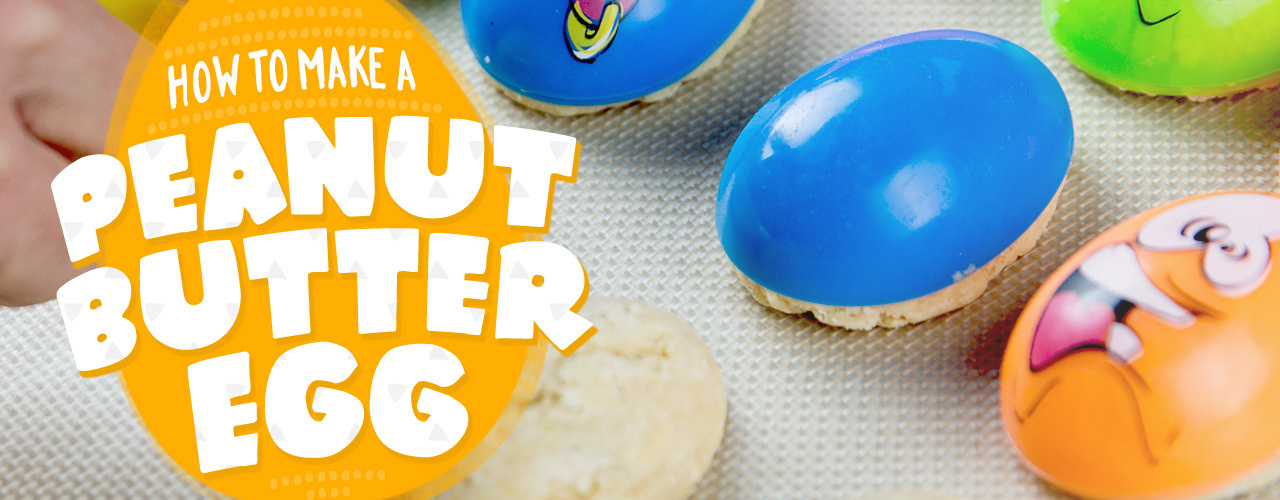Prepare your candy shop or bakery for springtime by making these delicious homemade peanut butter eggs. Only six ingredients are needed to make these no-bake confections and the steps are easy to follow. Featuring a thick, rich chocolate coating that gives way to a creamy peanut butter center, our peanut butter egg recipe is the perfect way to celebrate the Easter season.
Shop All Candy Making SuppliesHomemade Peanut Butter Eggs
Watch our video tutorial for homemade peanut butter eggs or read our recipe below:
Paraffin Wax in Chocolate
Food-grade paraffin wax is made of vegetable oils, palm oil derivatives, and synthetic resins that are considered safe to consume. Incorporating edible paraffin wax into melted chocolate adds shine and delivers a satisfying snap when you bite into the chocolate. It also helps the chocolate remain solid at room temperature.
What Special Equipment Do I Need?
To get started with this easy peanut butter egg recipe, you'll need the following items:
- Two Large Mixing Bowls - One large mixing bowl is needed to stir all of the ingredients together to make the peanut butter egg filling. You will also need a large mixing bowl to mix the chocolate chips and edible paraffin wax.
- Sheet Pan - The peanut butter eggs will be cooled on a sheet pan.
- Double Broiler - A double boiler allows you to gently melt the chocolate with indirect heat.
- Peanut Butter Egg Mold - Use an egg chocolate mold to ensure each batch of candies is consistently shaped.
- Silicone Baking Mat - Once the peanut butter eggs are dipped in chocolate, you will place them on the sheet pan lined with a silicone baking mat to ensure an easy release once the confections have hardened.
- Fork - You will need a fork to dip the peanut butter eggs into the chocolate coating.
- Easter Egg Window Boxes - The Easter egg window boxes feature an eye-catching pattern and clear window to help market your eggs.
- Easter Egg Box Inserts - Easter egg box inserts hold the peanut butter eggs securely in the boxes while on display or in transport.
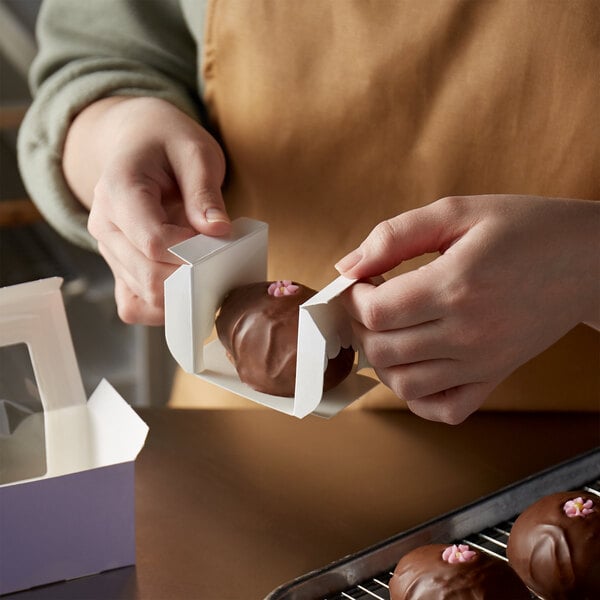
Peanut Butter Egg Recipe
Our no-bake peanut butter marshmallow egg recipe has a short, simple ingredient list and is easy to make. We use an old-time candy-making secret to make our peanut butter eggs: food-grade paraffin wax. Use the following ingredients and steps to make crowd-favorite, old-fashioned peanut butter eggs.
Yield: 12 to 24 peanut butter eggs
Peanut Butter Egg Ingredients:
- 1 1/2 cups butter
- 1 1/2 lb. confectioner's sugar
- 1 lb. semi-sweet chocolate chips
- 1 cup creamy peanut butter
- 7 oz. jar marshmallow creme
- 3/4 stick food-grade paraffin wax
Directions:
Depending on the size of your molds, this recipe makes 12 to 24 homemade peanut butter eggs. Our recipe converter helps adjust the peanut butter egg recipe ingredients to meet your quantity needs.
- Melt three sticks butter and let it cool a little (overly hot butter won’t allow filling to hold a dense consistency).
- Add melted butter, marshmallow creme, creamy peanut butter, and 1/2 lb. confectioner’s sugar to large mixing bowl.
- Mix ingredients until they reach a lumpy and runny consistency. Then, stir in remaining 1 lb. confectioner’s sugar until smooth and even.
- Scoop peanut butter egg filling into peanut butter egg molds.
- Place molds on sheet pan. Refrigerate until they are firm (about 1 to 2 hours).
- Add chocolate chips to large mixing bowl. Shave food-grade paraffin wax into bowl.
- Melt chocolate and wax in double boiler. Stir until it’s smooth enough to use as a dip.
- Remove sheet pan from the fridge and extract peanut butter filling from egg molds. Line empty sheet with a silicone baking mat.
- Place peanut butter egg on fork. Gently lower it into melted chocolate.
- Use fork to flip peanut butter egg. Then scoop coated egg out of chocolate and place it on lined sheet. Repeat for each egg.
- Refrigerate loaded sheet pan until chocolate coating hardens (about 10 to 20 minutes).
- Remove sheet pan from refrigerator. Place chocolate peanut butter eggs in Easter egg box inserts and load them into Easter egg window boxes.
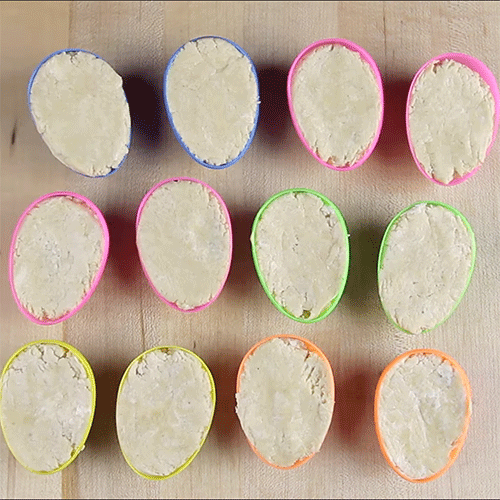
Peanut butter eggs are a low-cost, high-profit Easter treat. But don't just save this recipe for springtime! Use different chocolate molds to create other themed and seasonal candies for patrons. Display these eye-catching treats in your candy shop or store's bakery case to create a nostalgic atmosphere and generate impulse buys.
Related Resources
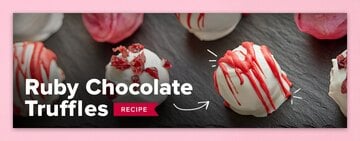
How to Make Ruby Chocolate Truffles
It's not every day that a new type of chocolate is invented! Ruby chocolate isn't just white chocolate with pink food coloring, it's a brand-new type of chocolate with a natural pink hue from ruby cocoa beans. If you're as excited as we are, check out our easy ruby chocolate truffle recipe. Can't wait to get your hands on some ruby chocolate? Click below. Shop for Ruby Chocolate Jump to Recipe Watch Our Video Ruby Chocolate Truffles Make a show-stopping confection and impress your guests by introducing them to ruby chocolate. Our ruby chocolate truffles are dipped in white chocolate and decorated three ways - topped with chopped cranberries, sprinkled with sparkly pink luster dust, and drizzled with melted red chocolate. Choose your favorite or try all three styles. How to Make Ruby Chocolate Truffles Watch our video tutorial for ruby chocolate truffles or read our recipe below: <iframe itemprop="embedURL" width="560" height="315" src="https://www.youtube.com/embed/4QSgKitfBuk" frameborder="0" allowfullscreen></iframe> What Special Equipment Do I Need? To get started with this ruby chocolate recipe, you'll need the following items: Double Boiler - Pair a double boiler with an induction cooking unit for the most precise control while heating the white and red chocolate chips. If you don't have a double boiler on hand, place a bowl over a saucepan of simmering water. Just make sure the water does not touch the bottom of the bowl because the chocolate will heat too quickly and burn. Small Saucepan - You will heat the heavy cream in a small saucepan. Medium Glass Bowl - The ruby chocolate will be gently melted by combining it with hot heavy cream in a medium-sized glass mixing bowl. Sheet Pans lined with parchment paper - Catch any melted chocolate drips with a sheet pan. Cooling Rack - Your ruby chocolate truffles will cool quickly on a baker's cooling rack. Rounded Scoop - Use a #70 round scoop (.5 ounce) for consistently sized truffles. Dipping Tools - Dipping tools make it easy to dip your truffles into melted chocolate. Luster Dust - Luster dust is an edible, shimmery powder that adds sparkle to your desserts. Try any shade you like, but we recommend pink. Tips from the Test Kitchen Shown here: Combining heavy cream with ruby chocolate. Ruby chocolate has its own unique makeup, so you'll find that it doesn't behave the same way that other types of chocolate do. Here are some tips from our test kitchen to help you achieve the best results with ruby chocolate: Color change - When you add additional ingredients to ruby chocolate (like milk or cream), the vibrant pink color will become muted. This is completely normal. If you want to brighten the chocolate, simply add a couple of drops of an oil-based food coloring. Do not use gel or liquid food coloring. Melting the chocolate - Ruby chocolate melts differently than other chocolates and may "break" or separate when heated. Our method of adding the hot cream to the chocolate is a gentle way to melt the chocolate and works better than heating the ruby chocolate directly. If the chocolate does start to separate on you, whisk it quickly to reincorporate the ingredients. Chocolate won't melt - If the ruby chocolate hasn't melted for you per our directions, you can use a microwave. But be warned! It's very easy to overheat chocolate in a microwave. You don't want to ruin your precious ruby chocolate, so only place the chocolate mixture in the microwave for 15-second increments. Let it sit for a minute and stir before trying again. Ruby Chocolate Truffles Recipe Add these colorful ruby chocolate truffles to your display case or use them in a festive dessert charcuterie board. They might look fancy, but they're surprisingly easy to make. Check out our test kitchen tips above before you get started with this recipe: Recipe by: Ronne Day, WebstaurantStore Food Stylist Yield: 20 to 24 truffles Total Time: 120 minutes Shown here: Drizzling melted red chocolate with a fork. Ruby Truffle Ingredients 1 pound Callebaut Ruby Couverture Callets, finely chopped 4 ounces heavy cream 1 1/2 pound Regal white melting chips 1/4 cup dried cranberries, finely chopped Pink luster dust 1/2 pound Regal red melting chips 1 - 2 Tablespoons of vegetable oil Directions Note: Wear gloves throughout this process. Place chopped ruby chocolate callets in medium glass bowl and set aside. In small saucepan over medium heat, warm heavy cream until steaming but not boiling. Pour cream over ruby chocolate and allow to rest for 1 minute. Do not skip this resting period. The chocolate will continue to melt as it sits. Gently stir ruby chocolate and cream mixture until chocolate is melted. Place mixture in refrigerator for 8 hours or overnight until firm. Dip .5 ounce scoop into ruby chocolate mixture and release truffles into your hands. Roll between your palms to make evenly portioned balls. You should have 20 to 24 truffles. Place on a sheet pan lined with parchment. Refrigerate 4 hours or until completely solid. Before decorating truffles, line sheet tray with parchment paper and place baker's rack on top. Heat white chips in double boiler until just melted. Whisk in up to 5 teaspoons of vegetable oil to increase fluidity, if necessary. Using two forks or truffle dipping tool, dip truffles into melted white chocolate and transfer to baker's rack. While freshly coated in white chocolate, top 1/3 of truffles with chopped cranberries. Transfer all truffles to refrigerator for 1 hour. After coating has set, gently brush luster powder onto 1/3 of truffles. Allow to sit for 30 minutes. Decorate the remaining 1/3 truffles. Melt red melting chips using the same process as white melting chips. Whisk in vegetable oil, 1 teaspoon at a time, until chocolate has a fluid consistency. Using the tines of a fork or a whisk, drizzle a little melted red chocolate over remaining 1/3 truffles. Allow to sit for 30 minutes to set. Cover and refrigerate all decorated truffles until ready to serve. Truffles will be good for two weeks in the refrigerator.
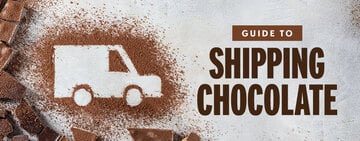
How to Ship Chocolate
Chocolate is a popular gift around Valentine's Day and Easter, but shipping chocolate can be a delicate process, as maintaining its quality and appearance during transit is crucial for customer satisfaction. From temperature control to packaging materials, several factors play a key role in ensuring that chocolates arrive at their destination in perfect condition. Whether you’re selling your treats online or shipping them from your storefront, understanding the best practices for shipping chocolate is essential for businesses looking to deliver a superior product to their customers. Shop All Mailing, Shipping, and Packing Supplies Use the following links to learn how to ship different chocolate candies: 1. Packing Chocolate for Shipping 2. Shipping Chocolate Without Melting 3. Best Way to Ship Chocolate 4. Shipping Chocolate Covered Strawberries 5. Shipping Chocolate Covered Pretzels 6. Shipping a Breakable Chocolate Heart 7. Create an Unboxing Experience Shipping Chocolate in the Mail Check out our quick video to learn how to package your chocolate products for shipping: <iframe itemprop="embedURL" width="560" height="315" src="https://www.youtube.com/embed/xpcuvH9YwW4?si=8xXcbQtKVVdMPzKd?rel=0" frameborder="0" allowfullscreen></iframe> How to Pack Chocolate for Shipping As a chocolatier, you put time, love, and labor into creating delicious chocolate candies. Put just as much care into packing them so they arrive to your customers looking just as good as they left. Learn how to pack chocolate for shipping by following the steps below: Work with cold, clean hands. Chocolate has a softening point lower than the human body temperature, so run your hands under cold water before packaging your chocolate. Keep your chocolates in a wine cooler before shipping them. Shipping chocolate requires careful temperature planning because cold induces sugar bloom while warmth melts the chocolate. Many chocolatiers store their chocolates in wine refrigerators to cool them down without causing sugar bloom before shipping them. Add your chocolates to a chocolate box. Remember to take the same care and consideration for presentation as packing your chocolates at your storefront. A positive unboxing experience goes a long way toward generating brand loyalty. Build your shipping box. Use an insulated shipping box that is double or triple the size of your chocolate container. The additional space separates your chocolate from the heat and protects your truffles from getting smashed if the box dents in transit. Line the bottom of your shipping box with metalized bubble packaging. Metalized packing bubbles deflect the heat, insulate the chocolates, and provide cushioning. Decide whether you need cold packs. Based on the time of year, destination, and distance your chocolates are traveling, determine how many cold packs you need to prevent your chocolates from melting. If using cold packs, place one on the bottom of the shipping container. Wrap the cold packs in a resealable plastic food bag or another leak-proof container. This precaution prevents condensation from hurting your chocolates or leaking into the shipping box. Insert the chocolate box into the shipping container. If applicable, surround it with cold packs. Fill all remaining gaps with packing materials. Add a sheet of metalized insulation to the top of the package. It should cover the entire top of the package. Secure the shipping box. Tape all the seams to keep warm air from getting in. Add the shipping labels and mark the package as perishable and fragile. Your chocolates are ready for shipment! Chocolate Packaging Supplies Use the following chocolate packaging supplies to prepare your chocolate for shipping. Insulated boxes for shipping Cold packs for shipping chocolate Metalized bubble wrap Chocolate box Shipping paper Tape Mailing and shipping labels How to Ship Chocolate Without Melting The most challenging part of shipping chocolate is preventing it from melting. Chocolate softens at 72 degrees Fahrenheit, which puts it at risk of smudging, taking on fingerprints, and receiving structural damage. While chocolate's heat sensitivity makes shipping precarious, chocolatiers can thrive in the e-commerce market by following chocolate shipping best practices. Elect to delay shipment orders. Some chocolatiers elect to delay shipments if the temperature spikes. As long as you communicate, customers are less frustrated by prolonged arrival than by ruined products. Use overnight shipping. If you plan to ship chocolates in the summer, use overnight shipping to ensure they arrive intact. Choose insulating and cooling packing materials. Metalized bubble packaging insulates your chocolates and deflects the heat. Nestling your chocolate box in ice packs keeps them below their softening point. Don’t ship chocolate orders from Thursday through Sunday. Shipments leading up to and on Saturday and Sunday remain in hot warehouses over the weekend. To avoid this, let your customers know you won't ship orders placed on these days until Monday. Send them an email confirmation once their order ships so they have confidence and clarity about your process. Provide an arrival alert. After working hard to ensure your chocolates remain intact during transit, the last thing you want is for them to melt on your client’s doorstep. Provide updates on the shipping progress so your customer can bring them inside as soon as they arrive. Should You Ship Chocolates in the Summer? Some chocolatiers forgo shipping chocolate in the summer months. You might lose some business by foregoing summer shipments, and the proper packaging makes this profit reduction avoidable. However, shipping chocolate in the summer may not be cost-effective based on the size of your operation and the location of your primary clientele. Ask yourself these three questions to determine whether your chocolate shop is up to filling summer shipment orders: Where are you shipping to? If most of your clients are from warm-weather areas, mailing chocolates in the dead of summer will be expensive. Is it cost-effective? The additional fees may scare off customers, making it unrealistic to stock chocolate shipping supplies over the summer for the number of orders received. How big is your operation? Shipping chocolates during the hottest months of the year requires a vigilant eye on weather patterns, careful packaging, and detailed shipping timelines. If you are the sole employee of your chocolate business or operate with a limited staff, you may not have the help you need to tackle summer chocolate shipments. If you can't choose between the risk of losing business or losing products, you could exclusively ship to cool weather states from June through August. Alternatively, you could include a pop-up link to other candies you ship during the summer if a potential customer tries to add chocolate to their online cart during the hottest months. Back to Top Best Way to Ship Chocolate Now that you know how to package your sweets, you must determine the best way to ship your chocolate. Many chocolatiers offer standard and expedited shipping based on the season and candy purchased. If your client lives in a destination warmer than 70 degrees Fahrenheit, consider requiring them to ship Next Day Air via UPS. In cooler climates, USPS two-day mail is a reliable and economical alternative. Follow our top tips for the best way to ship chocolate. Know your chocolate box dimensions and average weight. Before choosing a shipping carrier, you need to know your packages’ average dimensions and weight to pick the most affordable carrier for your products. Provide total transparency. If your customer’s shipment requires ice packs and other special packing materials, charge for them. Patrons appreciate transparency, so give a breakdown of shipment costs at checkout and include the price of the ice packs. Consider including shipping in the sales price. Offering free shipping discloses the total expense of ordering your chocolates from the start. This method helps prevent abandoned carts once the customers see the shipping fees. Offer custom tracking. Post-purchase platforms allow you to create a customized tracking page. That way, customers can get an idea of when to expect the package and retrieve them from the elements as soon as they arrive. How to Ship Chocolate Covered Strawberries Shipping temperature-sensitive and perishable chocolate-covered strawberries requires extreme care. Follow these steps to ship your chocolate-covered strawberries and prevent spoiling. Chill the strawberries. Refrigerate the strawberries for two hours or until hard to prevent the chocolate from melting in transit. Once cold, package and ship. Chocolate-covered strawberries that are refrigerated for more than a day will not arrive fresh at their shipping destination. Wrap each chocolate-covered strawberry. Cellophane wrap will mold itself to the strawberry. Once wrapped in cellophane, place the strawberries in large baking cups. Place the strawberries in a sturdy container with a tight sealing lid. The container needs to be durable enough to protect the strawberries. Leave an inch of buffer space between the strawberries to prevent them from bumping into each other. Add your box of strawberries to an insulated box. This larger box will ward off heat, preserve your strawberries’ freshness, and keep the chocolate from melting. Lay packing peanuts or packing bubbles on the bottom of your shipping box. This creates a cushioning layer for your strawberries. Fill the empty spaces in your shipping container with packing materials. Once you secure the strawberry box on all sides, layer packing materials on top and seal the shipping container with packing tape. Choose the fastest delivery service. Keep the chocolate-covered strawberries from spoiling by selecting overnight, express, or one-day delivery. How to Ship Chocolate Covered Pretzels Because pretzels are prone to breakage and chocolate is prone to melting, you must take exceptional care when shipping chocolate-covered pretzels. We explain how to ship chocolate-covered pretzels below. Package the pretzels. If you use pretzel rods, individually heat-seal each pretzel before adding them to a sealable food-grade bag. For regular pretzels, heat-seal your servings together. Bags absorb the impact if the carrier drops the shipping container. If you place the pretzels in a rigid container, they are more likely to shatter from crashing against the hard material. Label and seal the food-grade bag. Add branding to your chocolate-covered pretzels and create an attractive unboxing experience. Add the bag to a bubble mailer. Bubble mailers help protect your chocolate-covered pretzels during transit. Assemble a mailing box. You can pick up large mailing boxes for free at the post office. Tape all the seams to prevent cold air from escaping when you add the ice packs. Fill in the shipping box. Lay a cushioning bubble packaging layer on the bottom of the shipping box. Then, add your bubbled mailer and surround it with packing bubbles. Insert ice packs. For smaller orders, use one 6 oz. ice pack and nestle it to the side of your bubbled mailer. For larger orders, add two 6 oz. ice packs, one to the side of the bubbled mailers and one in between them. Seal the shipping box. Add another cushioning layer atop the contents before sealing your shipping box. Seal all the edges to contain the cold. How to Ship a Breakable Chocolate Heart Breakable chocolate hearts are hollow chocolate hearts filled with candy and sprinkles. They come equipped with mini mallets and make a cute, interactive dessert experience for Valentine’s Day or anniversaries. Given their fragile nature, you must take extra care to ensure your clients don’t receive a shattered heart. Learn how to ship a breakable chocolate heart below. Pack your breakable chocolate heart in a heart-themed chocolate box. This opportunity allows your branding to shine. Wrap the chocolate box in packing bubbles. The bubble packaging provides the first layer of protection. Assemble your shipping container. Tape all seals so warm air doesn’t leak into your box. Lay air pillows on the bottom of your shipping container. This buffers against rough handling. Add the chocolate box to the shipping container. Include any notes, details, or promotional flyers at this stage. Drape packing bubbles over the chocolate box before adding the ice packs. The bubble packaging protects your chocolates from condensation. Add three ice packs. Place one on top of the chocolate box and the remaining two on its sides. Leave no space. Fill all remaining areas with packing materials. Tape the shipping box closed. Seal all the seams to preserve a cool internal temperature. How to Create an Unboxing Experience A chocolatier’s priority is to have their shipments arrive intact, but a memorable unboxing experience goes a long way to boost brand loyalty. It provides free advertising when customers post their unboxing experience on social media. Here are some tips for creating a chocolate unboxing experience your customers will want to share. Ship your chocolate in branded boxes. Knowing the box is from your chocolate shop as soon as it arrives builds anticipation. Use attractive and sustainable packing materials. Customize your internal materials to create a cohesive aesthetic. If you use sustainable packaging, include an insert that shares this information with your customers. Environmental responsibility can earn respect and boost brand loyalty. Think like a merchandiser. Consider the color scheme of the cushioning materials and how they complement your items. Use dividers to manage your products' placement, and browse the social media hashtags #unboxing and #flatlay for inspiration. Provide free samples. Free samples introduce your clients to other product lines and encourage repeat business. For example, if your customer ordered a shipment of your chocolate truffles, consider adding a sample of your caramels or toffee. Personalize the package. From handwritten notes to customizable gift packaging, personal touches encourage repeat business. Add inserts. Insert coupons, new flavor/product promotions, or branded stickers. Mark the package as perishable. This label is for the customer, not the carrier. If someone sends your chocolates as a gift, you want the recipient to know they should open the box upon arrival. Shipping Chocolate FAQs These are some of the most commonly asked questions when it comes to shipping chocolate: Can You Freeze Chocolates? While freezing is an excellent preservation strategy when shipping baked goods, avoid it at all costs when shipping chocolate. Cooling chocolate, then exposing it to warm air, causes condensation to form on its surface. The moisture dissolves some of the chocolate's sugar content. When the sugar recrystallizes, it creates a white, grainy layer known as “sugar bloom" that distorts the taste and texture of your chocolate. While traditional freezing and refrigeration are ill-advised, some chocolatiers store their chocolates in a wine cooler to prevent them from softening. Operating between 45 and 67 degrees Fahrenheit, wine coolers are not as cold as refrigerators. Setting a wine cooler to its warmest operating temperature keeps ganache-filled truffles intact without inducing a sugar bloom. Do All Chocolate Candies Have the Same Melting Point? While the average melting point for chocolate across all types is between 86 and 90 degrees Fahrenheit, not all chocolate candies have the same melting point. Chocolate candies use two extracted portions of the cocoa bean: cocoa solids and cocoa butter. Most white and dark chocolate contain comparable amounts of cocoa butter, but chocolatiers increase the candies' darkness by adding more cocoa solids. Since white chocolate has no cocoa solids to absorb liquefying cocoa butter, it melts fast. Milk chocolate and ruby chocolate contain some cocoa solids, but not as much as dark chocolate. Back to Top With the rise of ghost kitchens, storefronts are no longer necessary to sell gourmet chocolate desserts. However, you need a solid shipping strategy to ensure your goodies arrive intact. Whether your chocolate shop is ramping up its shipping strategy or you want to create a virtual chocolate brand, use this resource to deliver your chocolates without compromising them.

Chocolate Melting Point Guide
Chocolate, with its rich and indulgent flavor, is a beloved ingredient in the culinary world. From decadent desserts to savory sauces, chocolate adds a touch of luxury to a wide range of dishes. However, not all chocolate is created equal when it comes to melting. When melting chocolate, understanding the melt points can help you achieve desired texture and sheen while preventing scorching or seizing. We’ll explore the different melting temperatures of chocolate so you can achieve the desired consistency and texture in your recipes. What Is the Melting Point of Chocolate? The melt point of chocolate refers to the temperature at which it transitions from a solid to a liquid state. This characteristic is determined by the cocoa butter content in the chocolate. Cocoa butter, the fat component of chocolate, is responsible for its smooth texture and ability to melt in the mouth. Different types of chocolate have varying amounts of cocoa butter, which directly affects their melt points. Dark chocolate typically has a higher melt point compared to milk chocolate due to its higher cocoa content. On the other hand, milk chocolate contains more milk solids and sugar, which lowers its melt point, making it more easily melted. White chocolate has no cocoa butter, giving it the lowest melt point. Just like with candy temperatures, it is important to monitor chocolate temperatures closely as you bake. Dark Chocolate Melting Point Dark chocolate typically contains the highest cocoa content of the chocolate types, with around 86% or more cocoa solids. This makes it more resistant to melting. It has a melting point ranging from 113 to 120 degrees Fahrenheit (45 to 48 degrees Celsius). This higher melting point makes dark chocolate ideal for applications that require stability at room temperature, such as molded chocolates or chocolate decorations. Milk Chocolate Melting Point Milk chocolate has a lower melting point than dark chocolate due to its higher sugar and milk content. It contains approximately 20% to 50% cocoa solids and typically melts between 104 and 115 degrees Fahrenheit (40 to 46 degrees Celsius). This lower melting point makes milk chocolate more suitable for applications where a softer texture is desired, such as chocolate coating for candies or drizzling over desserts. White Chocolate Melting Point White chocolate, which contains no cocoa solids but is made from cocoa butter, sugar, and milk solids, has the lowest melting point among the three types of chocolate. It melts at temperatures between 100 and 110 degrees Fahrenheit (38 to 45 degrees Celsius). This low melting point makes white chocolate delicate and more prone to melting. It is a popular choice for baking, ganache, and confectionery fillings. Why Does Chocolate Melt at Different Rates? The melting point of chocolate is determined by its crystalline structure. Chocolate contains six different types of chocolate crystals, each with its own melting point. These crystals are formed during the chocolate-making process and can affect how the chocolate behaves when heated. Chocolates with lower melt points are more prone to that ashy-looking blooming which can lead consumers to believe the chocolate has gone bad. It's important to note that the melting point of chocolate can be influenced by external factors such as humidity and the presence of other ingredients. Humidity can cause chocolate to absorb moisture, resulting in a higher melting point and a grainy texture. The addition of ingredients such as cream or butter can lower the melting point of chocolate, as these ingredients interfere with the cocoa butter's crystalline structure. Chocolate Crystal Types There are six different types of chocolate crystals, also known as the polymorphs of chocolate, each with its own unique melting properties. Type 1 or Form I: (Melts around 64 degrees Fahrenheit) Soft and noticeable chocolate blooming, produced when melted chocolate is rapidly cooled. Type 2 or Form II: (Melts around 74 degrees Fahrenheit) Crumbly texture that melts easily, shows noticeable bloom. Type 3 or Form III: (Melts around 78 degrees Fahrenheit) Some firmness, melts easily, shows some blooming, does not ‘snap’. Type 4 or Form IV: (Melts around 82 degrees Fahrenheit) Mostly firm, melts easily, dull ‘snap’ and sheen. Type 5 or Form V: (Melts around 93 degrees Fahrenheit) Most stable form of chocolate, forms when tempering, smooth and glossy, has a good ‘snap’, melts easily in your mouth. Type 6 or Form VI: (Melts around 97 degrees Fahrenheit) Very firm, hard to snap, best for chocolate sculptures. Understanding the different types of chocolate crystals and their melting properties can help you choose the right type of chocolate for your specific commercial application. Whether you're creating a chocolate coating that needs to withstand warmer temperatures or a creamy ganache with a smooth texture, selecting the appropriate chocolate with the desired crystal form is key to achieving the desired results. Chocolate Tempering Temperatures Tempering is a crucial step in working with chocolate, as it ensures that the chocolate sets properly with a glossy appearance and smooth texture. Most chocolates for shipping and retail are tempered to ensure their stability and presentation. Tempered chocolate is gently melted to a precise temperature and then seeded with a portion of unmelted chocolate to cool it slowly and create those Type V chocolate crystals. It is then heated once more to incorporate the seeded chocolate and stabilize the crystals. Use the following tempering chocolate temperatures for your recipes: Dark Chocolate: Melt to 120 degrees Fahrenheit, seed and cool to 86 degrees Fahrenheit, reheat to 89 - 90 degrees Fahrenheit Milk Chocolate: Melt to 115 degrees Fahrenheit, seed and cool to 82 degrees Fahrenheit, reheat to 85 - 87 degrees Fahrenheit White Chocolate: Melt to 113 degrees Fahrenheit, seed and cool to 79 degrees Fahrenheit, reheat to 82 - 84 degrees Fahrenheit By understanding the melt points of different types of chocolate, commercial chefs and bakers can make informed decisions about which chocolate to use for specific applications. So if you own a candy store and are tempering chocolate for molding, creating ganache for truffles, or making a decadent chocolate sauce, knowing the melt point of your chocolate will ensure that you achieve the desired results.
